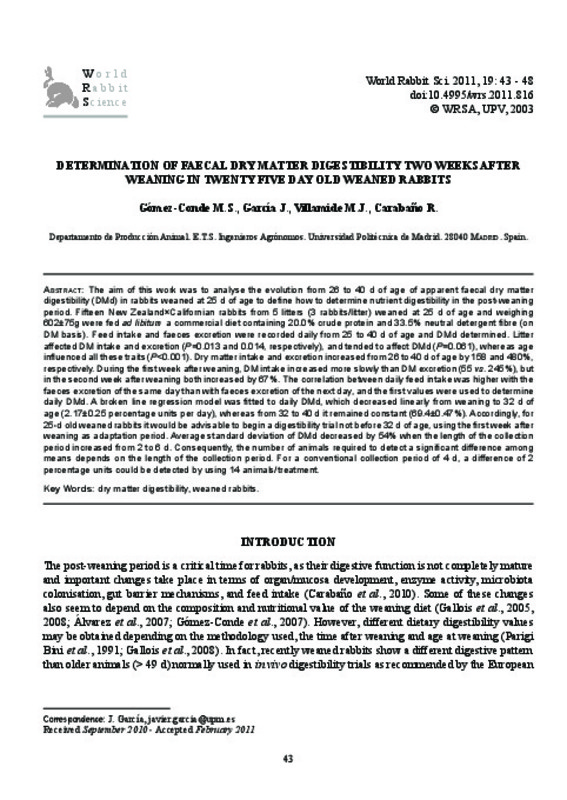JavaScript is disabled for your browser. Some features of this site may not work without it.
Buscar en RiuNet
Listar
Mi cuenta
Estadísticas
Ayuda RiuNet
Admin. UPV
Determination of faecal dry matter digestibility two weeks after weaning in twenty five day old weaned rabbits
Mostrar el registro sencillo del ítem
Ficheros en el ítem
| dc.contributor.author | Gómez-Conde, M.S.
|
|
| dc.contributor.author | García, J.
|
|
| dc.contributor.author | Villamide, M.J
|
|
| dc.contributor.author | Carabaño, R.
|
|
| dc.date.accessioned | 2011-05-09T13:05:10Z | |
| dc.date.issued | 2011 | |
| dc.identifier.issn | 1257-5011 | |
| dc.identifier.uri | http://hdl.handle.net/10251/10907 | |
| dc.description.abstract | [EN] The aim of this work was to analyse the evolution from 26 to 40 d of age of apparent faecal dry matter digestibility (DMd) in rabbits weaned at 25 d of age to define how to determine nutrient digestibility in the post-weaning period. Fifteen New Zealand ' Californian rabbits from five litters (3 rabbits/litter) weaned at 25 d of age and weighing 602±75g were fed ad libitum a commercial diet containing 20.0% crude protein and 33.5% NDF (on DM basis). Feed intake and faeces excretion were recorded daily from 25 to 40 d of age and DM digestibility determined. Litter affected DM intake and excretion (P = 0.013 and 0.014, respectively), and tended to affect DMd (P = 0.061), whereas age influenced all these traits (P < 0.001). Dry matter intake and DM excretion increased from 26 to 40 d of age by 158 and 480%, respectively. During the first week after weaning, DM intake increased more slowly than DM excretion (55 vs. 245%), but in the second week after weaning both increased by 67%. The correlation between daily feed intake was higher with the faeces excretion of the same day than with faeces excretion of the next day, and the first values were used to determine daily DMd. A broken line regression model was fitted to daily DMd, which decreased linearly from weaning to 32 d of age (2.17 ± 0.25 percentage units per day), whereas from 32 to 40 d it remained constant (69.4 ± 0.47%). Accordingly, for 25-d old weaned rabbits it would be advisable to begin a digestibility trial not before 32 d of age, using the first week after weaning as adaptation period. Average standard deviation of DMd decreased by 54% when the length of the collection period increased from 2 to 6 d. Consequently, the number of animals required to detect a significant difference among means depends on the length of the collection period. For a conventional collection period of four days, a difference of 2 percentage units could be detected by using 14 animals/treatment. | es_ES |
| dc.language | Inglés | es_ES |
| dc.publisher | World Rabbit Science. ICTA. UPV | es_ES |
| dc.relation.ispartof | World Rabbit Science | |
| dc.rights | Reserva de todos los derechos | es_ES |
| dc.subject | Dry matter digestibility | es_ES |
| dc.subject | Weaned rabbits | es_ES |
| dc.title | Determination of faecal dry matter digestibility two weeks after weaning in twenty five day old weaned rabbits | es_ES |
| dc.type | Artículo | es_ES |
| dc.date.updated | 2011-05-06T13:12:20Z | |
| dc.identifier.doi | 10.4995/wrs.2011.816 | |
| dc.rights.accessRights | Abierto | es_ES |
| dc.description.bibliographicCitation | Gómez-Conde, M.; García, J.; Villamide, M.; Carabaño, R. (2011). Determination of faecal dry matter digestibility two weeks after weaning in twenty five day old weaned rabbits. World Rabbit Science. 19(1):43-48. https://doi.org/10.4995/wrs.2011.816 | es_ES |
| dc.description.accrualMethod | SWORD | es_ES |
| dc.relation.publisherversion | http://doi.org/10.4995/wrs.2011.816 | |
| dc.description.upvformatpinicio | 43 | |
| dc.description.upvformatpfin | 48 | |
| dc.description.volume | 19 | |
| dc.description.issue | 1 | |
| dc.identifier.eissn | 1989-8886 | |
| dc.identifier.eissn | 1989-8886 | es_ES |








